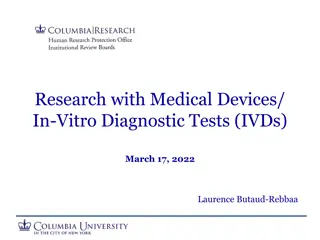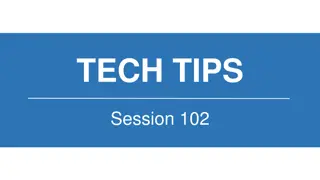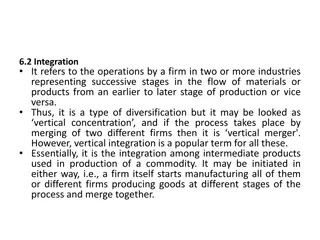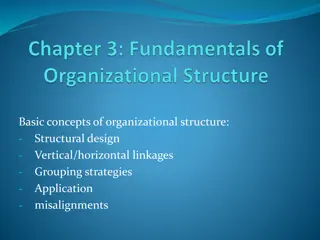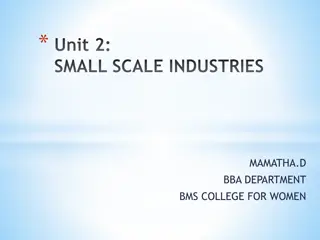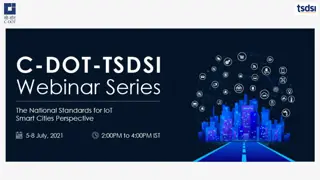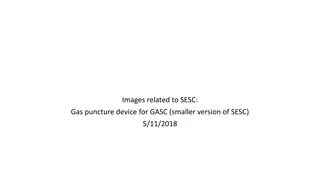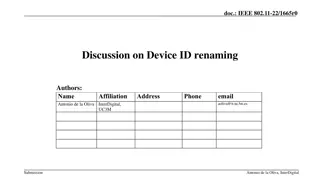Understanding SDT in oneM2M: Device Modeling for Vertical Industries
SDT (Smart Device Template) in oneM2M plays a crucial role in standardizing device modeling across various industry alliances. It aims to simplify the process for manufacturers, ensure modularity, facilitate API development, and allow for extendibility without service disruption. This overview covers SDT's basic elements, term definitions, data types, and its interworking capabilities within and outside oneM2M.
Download Presentation

Please find below an Image/Link to download the presentation.
The content on the website is provided AS IS for your information and personal use only. It may not be sold, licensed, or shared on other websites without obtaining consent from the author. Download presentation by click this link. If you encounter any issues during the download, it is possible that the publisher has removed the file from their server.
E N D
Presentation Transcript
oneM2M SDT and its usage oneM2M SDT and its usage in a typical vertical industry in a typical vertical industry Prof. Han, Andrew Min-gyu (andyhan@hansung.ac.kr) oneM2M TDE WG Chair, HANSUNG University 6th oneM2M Industry Day hosted by TSDSI 25-Sep-2019 1
Introduction of SDT SDT: Smart Device Template To find consensus amongst various SDOs and industry alliances to derive a common approach for device modeling. oneM2M and partners have the approach to agree on a set of automation functionalities, following a common syntax, which are sufficient to model most device functions. The key goals of the SDT are: 1. keep it simple, especially for manufacturers to contribute device information 2. modularity for functions and device types 3. make it easy for developers to create unified APIs 4. be independent of underlying LAN technologies and protocols 5. enable extendibility of the system in place without service interruption 6. allow a pass-through mechanism to enable use of proprietary or technology- specific functions. 6th oneM2M Industry Day hosted by TSDSI 25-Sep-2019 2
SDT Overview SDT 4.0 Basic Elements 6th oneM2M Industry Day hosted by TSDSI 25-Sep-2019 3
SDT Overview Term Definition Unique name, or "wrapper" which acts like a namespace, set by the organization, company, or project creating the template, allowing reference to a package of definitions for the contained ModuleClasses and device definitions. Can be referenced when extending Products, ModuleClasses, and data types. It has two possible uses: to select the scope of a technology domain, or to set the scope of a use case domain (like Home, SmartGrid, etc) Domain A concrete device model with deterministic device Properties and ModuleClasses, without optionality. It is deemed as a specialized implementation of a DeviceClass that can be manufactured. ProductClass DeviceClass A physical, addressable, identifiable appliance, sensor, or actuator. A device (usually one of several) which may be embedded in or attached to a (full) device. It is not designed to be operated as a standalone device. Sub-Device Specification of a single service with one or more service methods, the involved abstracted data model and related events. The expectation is that each separate service which may be used in many kinds of devices (like PowerON/OFF, Open/Close, ...) will be described by a ModuleClass which can be re-used in many DeviceClass or ProductClass definitions. ModuleClass 6th oneM2M Industry Day hosted by TSDSI 25-Sep-2019 4
SDT Overview SDT 4.0 Data Type 6th oneM2M Industry Day hosted by TSDSI 25-Sep-2019 5
SDT in oneM2M and non-oneM2M interworking ASN or MN IN Utility Application Mca C CSE CSE Mcc B A SDT Data model Awareness Mca AE: Inter-working Proxy (SDT mapping inside) Specific Data model Awareness Hue REST API Philips Hue Bridge NoDN Philips Hue Bulb B Philips Hue Bulb A NoDN NoDN 20-Sep-2017 3rd oneM2M Industry Day hosted by TSDSI 6
SDT usage in vertical industry City domain example deviceOutdoorLamp Module Instance Name binarySwitch brightness motionSensor airQualitySensor uvSensor timer Module Class Name binarySwitch brightness motionSensor airQualitySensor uvSensor timer Optional false true true true true true Description See clause 5.3.1.12. See clause 5.3.1.17. See clause 5.3.1.54. See clause 5.3.1.6. See clause 5.3.1.92. See clause 5.3.1.90. The timer is used to set duration of giving lights from the moment of triggering by the brightness module or motionSensor module. See clause 5.3.1.34. faultDetection faultDetection true 6th oneM2M Industry Day hosted by TSDSI 25-Sep-2019 7
SDT usage in vertical industry City domain example (cont d) Actions of binarySwitch ModuleClass Return Type Name none toggle Argument none Optional true Documentation Toggle the switch. DataPoints of binarySwitch ModuleClass Name state Type R/W RW Optional false Unit Documentation The current status of the binarySwitch. "True" indicates turned-on, and "False" indicates turned-off. xs:boolean 6th oneM2M Industry Day hosted by TSDSI 25-Sep-2019 8
SDT usage in vertical industry City domain example (cont d) DataPoints of brightness ModuleClass Name Type R/W brightness xs:integer RW Optional false Unit pct Documentation The status of brightness level. DataPoints of motionSensor ModuleClass Name Type R/W Optional false true Unit Documentation alarm silentTime xs:boolean xs:integer R RW The detection of the motion occurrence. The time that a motionSensor restrains from sending an alarm in case continous motions are detected after one alarm is produced. This data point can be used to avoid repeated alarm reports. The level of the detection accuracy of the motion sensor. This data point can be used to control the number of the report. s sensitivity xs:integer RW true 6th oneM2M Industry Day hosted by TSDSI 25-Sep-2019 9
SDT usage in vertical industry City domain example (cont d) DataPoints of airQualitySense ModuleClass Name Type R/W Optional monitoringEnabled xs:boolean R true Unit Documentation The current status of monitoring. "True" indicates enabled, and "False" indicates not enabled. The concentration of particle matter under 1 .. The minimum value is 0. The concentration of particle matter under 2.5 . The minimum value is 0. The concentration of particle matter under 10 . The minimum value is 0. Total suspended particle. The concentration of odor that reflects air pollution. The minimum value is 0. The measured humidity. The minimum value is 0, and the maximum value is 100. The current temperature The air pressure. This value indicates the CO level. This value indicates the CO2 level. This value indicates the CH2O level. This value indicates the VOC (Volatile Organic Compounds). This value indicates the concentration of NO2. This value indicates the concentration of SO2. This value indicates the concentration of O3. This value indicates the level of noise. The wind direction. The value range is [0-359]. North is 0.0 degrees, east is 90.0 degrees, south is 180.0 degrees, west is 270.0 degrees. g/m3 g/m3 g/m3 g/m3 OU/m3 pct C KPa mg/m3 mg/m3 g/m3 ppm g/m3 g/m3 g/m3 dB deg pm1 pm25 pm10 tsp odor humidity temperature airPressure co co2 ch2o voc no2 so2 o3 noise windDirection xs:integer xs:integer xs:integer xs:float xs:integer xs:float xs:float xs:float xs:float xs:float xs:float xs:float xs:float xs:float xs:float xs:float xs:float R R R R R R R R R R R R R R R R R true true true true true true ture ture true true true true true true true true true 6th oneM2M Industry Day hosted by TSDSI m/s The wind speed 25-Sep-2019 10 windSpeed xs:float R true
SDT usage in vertical industry City domain example (cont d) DataPoints of brightness ModuleClass Name Type R/W brightness xs:integer RW Optional false Unit pct Documentation The status of brightness level. DataPoints of motionSensor ModuleClass Name Type R/W Optional false true Unit Documentation alarm silentTime xs:boolean xs:integer R RW The detection of the motion occurrence. The time that a motionSensor restrains from sending an alarm in case continous motions are detected after one alarm is produced. This data point can be used to avoid repeated alarm reports. The level of the detection accuracy of the motion sensor. This data point can be used to control the number of the report. s sensitivity xs:integer RW true 6th oneM2M Industry Day hosted by TSDSI 25-Sep-2019 11
SDT usage in vertical industry City domain example (cont d) DataPoints of uvSensor ModuleClass Name Type R/W uvValue xs:float R uvStatus hd:enumUv Status Optional false true Unit Documentation mW/cm2 R The uvStatus indicates the level of the UV radiation status (see clause 5.6.35). Actions of timer ModuleClass Return Type none Name Argument None None Optional true true Documentation activateClockTimer deactivateClockTimer Activate current clock timer. Deactivate current clock timer. 6th oneM2M Industry Day hosted by TSDSI 25-Sep-2019 12
SDT usage in vertical industry City domain example (cont d) DataPoints of timer ModuleClass Name Type R/W Optional referenceTimer xs:integer R true Unit Documentation A timer (for example. a time-based value, App Defined Epoch, Progressive) expressed in seconds. The value indicates a time counter to be used as reference for the other time- based data points of this ModuleClass. Usually it is the time since the last event of power-on of the producer (or more in detail the time since the boot of its connectivity node). A time span (for example a time-based value, App Defined Epoch, Fixed) expressed in seconds. The value indicates the time when the appliance is expected to start its operation, starting counting from the last referenceTimer . A time span (for example a time-based value, App Defined Epoch, Fixed) expressed in seconds. The value indicates the time when the appliance is expected to stop its operation, starting counting from the last referenceTimer . A timer (for example a time-based value, App Defined Epoch, Progressive) expressed in seconds. The value indicates the time to the end of an appliance s operations. It is calculated at runtime by the device itself during the execution of its operation. A timer (for example a time-based value, App Defined Epoch, Progressive) expressed in seconds. It indicates the time of the current operation. Usually its value is increasing one value per second. It starts counting from 0 when the operation starts and stops counting when the operation ends. A time span (for a time-based value, App Defined Epoch, Fixed) expressed in seconds. The value indicates a time that represents the target duration of the operation as per user selection. An absolute time to specify the start time. An absolute time to specify the stop time. xs:integer RW true targetTimeToStart xs:integer RW true targetTimeToStop xs:integer R true estimatedTimeToEnd xs:integer R true runningTime xs:integer R true targetDuration m2m:timestamp m2m:timestamp RW RW true true absoluteStartTime absoluteStopTime 6th oneM2M Industry Day hosted by TSDSI 25-Sep-2019 13
SDT usage in vertical industry City domain example (cont d) DataPoints of uvSensor ModuleClass Name Type R/W uvValue xs:float R uvStatus hd:enumUv Status Optional false true Unit Documentation mW/cm2 R The uvStatus indicates the level of the UV radiation status (see clause 5.6.35). Actions of timer ModuleClass Return Type none Name Argument None None Optional true true Documentation activateClockTimer deactivateClockTimer Activate current clock timer. Deactivate current clock timer. 6th oneM2M Industry Day hosted by TSDSI 25-Sep-2019 14
SDT usage in vertical industry City domain example (cont d) DataPoints of faultDetection ModuleClass Name Type R/W status xs:boolean R code xs:integer R description xs:string R Optional false true true Unit Documentation The status of fault detection. The numeric representation of the fault. The message representation of the fault. 6th oneM2M Industry Day hosted by TSDSI 25-Sep-2019 15
SDT usage in vertical industry Railway domain example deviceHandheldPTTTerminal Module Instance Name binarySwitch audioVolume battery clock energyConsumption keypad operationMode phoneCall PTTButton runState signalStrength Module Class Name binarySwitch audioVolume battery clock energyConsumption keypad operationMode phoneCall pushButton runState signalStrength Optional false false false true true false true false false true true Description See clause 5.3.1.12. See clause 5.3.1.8 See clause 5.3.1.10. See clause 5.3.1.18. See clause 5.3.1.32. See clause 5.3.1.49. See clause 5.3.1.57. See clause 5.3.1.64. See clause 5.3.1.69. See clause 5.3.1.75. See clause 5.3.1.78. 6th oneM2M Industry Day hosted by TSDSI 25-Sep-2019 16
SDT usage in vertical industries Common Domain ModuleClass: 99 DeviceModel: 15 City Domain DeviceModel: 7 Health Domain DeviceModel: 5 Home Domain DevceiModel: 29 Industry Domain Vehicular Domain DeviceModel: 1 Railway Domain DeviceMode: 2 TS-0023: SDT based Information Model and Mapping for Vertical Industries provides 99 ModuleClasses, 59 DeviceModels for 7 Vertical Domains and will does more! 6th oneM2M Industry Day hosted by TSDSI 25-Sep-2019 17
Thank you! 6th oneM2M Industry Day hosted by TSDSI 25-Sep-2019 18



